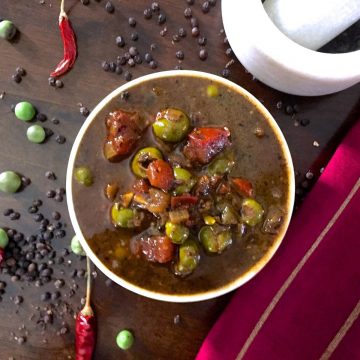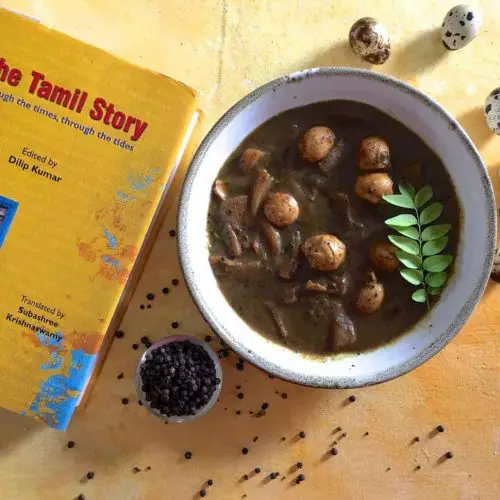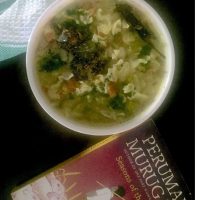An earthy, spicy, flavourful gravy, the fresh sundakkai (turkey berry) gives a great texture to this Pachai Sundakkai Puli Kuzhambu. Pachai, in Tamizh, is green/ fresh as opposed to the dried form in which this berry is popularly used.

Jump to:
It is only last year that I started cooking with these green berries, though the dried vathal version is one I have been used to since the days of my mother's sundakkai vathal kuzhambu. The community farms from where I have been buying my veggies for the last 3-4 months had sundakkai as one of the items on sale and got me to trying them out in different recipes.
I first made this kuzhambu last year from a batch of fresh turkey berries which my friend in Chennai, Theyan, generously gave from her garden. She shared her recipe too. I need to try out her method which uses ground spices rather than the spice paste that I make. I will update this post once I make it from that recipe.
Possible Health Benefits of Turkey Berries
Sundakkai/ Turkey berries are believed to have various nutritional and medicinal properties. To read more about this, refer this article on Healthline.
What is the Difference Between Puli Kuzhambu and Kara Kuzhambu
I did some research on this question, as I was initially rather confused. From what I now understand, when the base sauce/ gravy is predominantly or wholly from tamarind extract, this is a puli kuzhambu. When tomatoes join the party, it becomes a kara kuzhambu. Puli kuzhambu is usually a little thinner than a kara kuzhambu. Hence in this specific Sundakkai kuzhambu recipe, if you omit the onion and tomato and make the kuzhambu a little more fluid, it becomes a puli kuzhambu. Either way, the dish is delicious and perfect comfort food on a rainy day. Or any other day for that matter.
How To Cook Pachai Sundakkai/ Fresh Turkey Berry?
1. The important step is to first gently crush each berry ( I used a small mortar and pestle) and then to rinse and drain. This, I understand, removes some of the bitterness from the berries.
2. When you add the sundakkai berries to the gravy as in the instructions below, stir them well for two minutes so that they are fried through.
To Make the Sundakkai Kuzhambu
1. There are different versions of pachai sundakkai puli kuzhambu. I have opted here for one with both onion and garlic as they add both flavour and a richer consistency to the dish. You could leave these two out if you prefer. I don't add onion and garlic to vathal kuzhambu, though.
2. For the kuzhambu to get its traditional flavours and aroma, gingelly/ til oil (popularly used in Tamizh and some South Indian cooking and extracted from sesame seeds) is the best fit. Alternatively, a mild vegetable oil such as sunflower seeds oil may be used. A stronger flavoured oil such as coconut or mustard would probably overwhelm the taste of the spices and change the flavour profile of the dish.
3. The tamarind extract should be allowed to cook well and to reduce by about a third, to get the best flavours and thickness for the kara kuzhambu.

Sundakkai Theeyal is next on my list, while the season for the berries lasts. If I have enough fresh sundakkai left over, I will soak them in curd and sun dry to make vathal.
Other Recipes From Tamil Cuisine
"Recipe"

Pachai Sundakkai Puli Kuzhambu/ Sundakkai Kara Kuzhambu
Ingredients
For Tamarind Extract
- 2 tablespoons Tamarind pulp 1 Indian lemon sized ball
- 2 cups Water
For Spice/ Masala Paste
- ½ tablespoon Gingelly Oil/ Til Oil or a mild flavoured vegetable oil such as sunflower oil
- ¼ teaspoon Vendhayam seeds/ Methi seeds / Fenugreek seeds
- ½ teaspoon Black peppercorns
- 1 teaspoon Kothamalli vera/ Dhania seeds/ Coriander seeds
- 1 teaspoon Kadalai paruppu/ Channa dal / Split Bengal Gram lentils
- ½ teaspoon Ulutham paruppu/ split urad dal/ split skinless black gram lentils
- 4 Dry Red chilies
- ⅛ teaspoon Asafoetida powder / 1 pinch
- 1 sprig Curry leaves 5-8 leaves
- 2 cloves Garlic
- 2-3 tablespoons Water
Other Ingredients for Pachai Sundakkai Kuzhambu
- ½ cup Sundakkai/ Turkey Berries /slightly crushed, rinsed, drained
- 1 cup Onions / chopped small
- 2 cloves Garlic
- ½ cup Tomato / chopped small
- 2 tablespoons Gingelly Oil/ Til Oil or a mild flavoured vegetable oil such as sunflower oil
- ½ teaspoon Mustard seeds
- ½ teaspoon Jeera seeds/ Cumin seeds
- ¼ teaspoon Vendhayam seeds/ Methi seeds / Fenugreek seeds
- ¼ teaspoon Manjal podi/ Haldi / Turmeric powder
- ¼ teaspoon Red chili powder
- ⅛ teaspoon Asafoetida powder / 1 pinch
- 1 sprig Curry leaves 5-8 leaves
- ½ teaspoon Salt /or to your taste
Instructions
Preparation
- Soak the tamarind in water. I soak it in mildly warm water for 20 minutes if I have not soaked the tamarind an hour or so in advance, but not in boiling hot water. After soaking, squeeze the tamarind with your hand and extract the juice. Filter out any tamarind pulp/ fibre that remains.
- Crush each sundakkai berry gently in a mortar and pestle so that a little of the skin splits, but without crushing it so much that it becomes shapeless or all the pulp gets out. Rinse the crushed berries briefly and set them to drain. Pat dry with a kitchen towel/ tissue before adding to the pan as in instructions below.
- Peel and chop onion into small pieces. Peel the garlic and crush 2 cloves for the kuzhambu. Chop the tomato into small pieces.
To Make the Spice Paste/ Masala Paste
- Heat the oil and add the items in the ingredients list for this paste, one after the other, sauteeing each for 3-5 seconds on low flame. First the methi seeds, to be sauteed till the colour darkens, then the pepper, then the dhania/ coriander seeds. Follow this with the paruppu (channa dal and urad dal), saute till they begin to darken but without letting them char/ burn. Add dry red chilies after removing the stalks, and then the hing/ asafoetida. If you prefer, saute them with the stalks and remove the stalks before grinding the paste.Shred the curry leaves and add (stand back a bit as the oil may spatter if the leaves are fresh). I usually shred the curry leaves so that there is more chance of their being consumed rather than discarded.Add the garlic cloves, saute for 10 seconds.
- Remove the fried spices to a dry heat proof bowl, and once it is cool, grind to a paste with about 3 tablespoons of water.
To Make Pachai Sundakkai Kuzhambu
- Heat a pan, add oil. Once the oil is hot (before it get smoking hot), reduce the flame. Add mustard seeds, let them burst. Add methi seeds, saute for 2 seconds or till they begin to darken in colour. Add jeera/ cumin seeds, saute for 2 seconds.
- Add haldi/ turmeric powder, red chili powder, hing/ asafoetida powder and saute about 1 minute, till the raw smell reduces, stirring frequently so that the powders do not catch at the bottom of the pan.
- Add shredded curry leaves. Stir.Add crushed garlic cloves. Stir and saute for 20 seconds.Add chopped onion. Saute for about 3 minutes on high, stirring frequently till the onions become translucent. Make sure they do not char.Add the chopped tomatoes, stir well, keeping the heat on high, for about 1 minute.Add the partly crushed, rinsed and dried sundakkai berries. Stir well, keeping on high for about 2 minutes.
- Add the prepared masala paste, stir well.Add Tamarind extract. Add salt (always safer to add a little, boil, taste and then add a little more if required).
- Bring the kuzhambu to a boil on high, then reduce to low heat and allow it to simmer till the volume of kuzhambu is reduced by about ⅓ to about 1.5 cups.Have it hot, with a poriyal and rice










Swati says
Sounds such a comforting and delicious stew.. would love to try it .. I think these berries are not available in Northern States of India ?
Sujata Shukla says
Hi Swati and thanks for visiting my blog. The Sundakkai kuzhambu is very tasty and is absolute comfort food, as well as having health benefits. It should be available in North India as it has a name in Hindi, bhankatiya. However I have not come across any recipes for this berry in Northern India, so perhaps it is not used in cooking there.